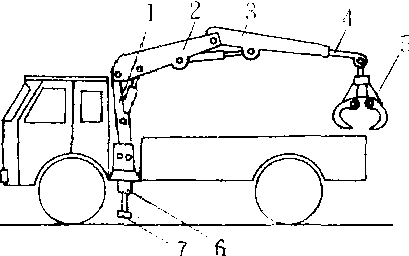随车起重机lorry crane
在运材汽车上,配备铰接式的液压起重臂,能自行装卸原木的流动式起重机。液压起重臂位于汽车驾驶室与货厢之间。由主臂、副臂、伸缩臂、转柱、底梁、抓具和液压系统的部件等组成。各机构全部采用液压传动,当汽车发动机带动油泵转动后,高压油输入各工作油缸或油马达,于是液压起重机可产生主臂与副臂曲折、转柱旋转、支腿收放、伸缩臂伸缩、抓具回转和抓爪开闭等动作。液压起重臂装车后将动臂折叠在驾驶室顶部而不占货厢位置。它工作平稳,操纵灵活,生产率高。适用汽车运材及贮木场、堆栈装卸作业。

随车起重机
1.转柱 2. 主臂 3. 副臂 4.伸缩臂 5.抓具 6. 底梁 7.支腿